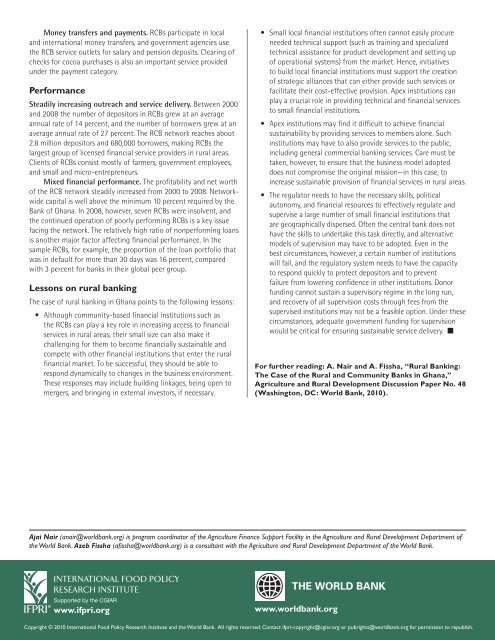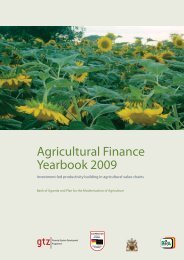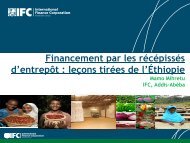<strong>Innovations</strong> <strong>in</strong> <strong>Rural</strong> <strong>and</strong> <strong>Agriculture</strong> F<strong>in</strong>ance<strong>Rural</strong> Bank<strong>in</strong>g: The Case of <strong>Rural</strong> <strong>and</strong> Community Banks <strong>in</strong> GhanaAjai Nair <strong>and</strong> Azeb FisshaFor Food, <strong>Agriculture</strong>,<strong>and</strong> the EnvironmentBefore the late 1970s, rural dwellers <strong>in</strong> Ghana had almost noaccess to <strong>in</strong>stitutional credit for farm <strong>and</strong> nonfarm activities,<strong>and</strong> <strong>in</strong> many rural communities, secure, safe, <strong>and</strong> convenient sav<strong>in</strong>gs<strong>and</strong> payment facilities hardly existed. In response to this situation,the Government of Ghana took several measures to <strong>in</strong>crease accessto credit <strong>in</strong> rural areas, <strong>in</strong>clud<strong>in</strong>g facilitat<strong>in</strong>g the establishment ofrural <strong>and</strong> community banks (RCBs). This brief discusses the historyof RCBs, their bus<strong>in</strong>ess model, their services, <strong>and</strong> their f<strong>in</strong>ancialperformance. It then draws some lessons relevant for others<strong>in</strong>volved <strong>in</strong> or plann<strong>in</strong>g similar <strong>in</strong>itiatives.As a network, RCBs are the largest providers of formal f<strong>in</strong>ancialservices <strong>in</strong> Ghana’s rural areas. By the end of 2008, Ghana had127 RCBs with a total 584 service outlets, represent<strong>in</strong>g about half ofthe total bank<strong>in</strong>g outlets <strong>in</strong> the country. The RCB network reachesabout 2.8 million depositors <strong>and</strong> 680,000 borrowers. Although theservice delivery performance of the RCB network has been strong,its f<strong>in</strong>ancial performance has been mixed. The profitability <strong>and</strong> networth of the network have grown, but the f<strong>in</strong>ancial performance ofsome members has been poor, <strong>and</strong> a small number are <strong>in</strong>solvent.The creation <strong>and</strong> evolution of the RCBsThe first RCB was established <strong>in</strong> a farm<strong>in</strong>g community <strong>in</strong> the Centralregion of Ghana <strong>in</strong> 1976. Several others were established <strong>in</strong> rapidsuccession, <strong>and</strong> by 1984 the number of RCBs reached 106. By theearly 1980s, however, the f<strong>in</strong>ancial performance of many RCBsstarted to decl<strong>in</strong>e for several reasons, <strong>in</strong>clud<strong>in</strong>g a 1983 drought,weak govern<strong>in</strong>g ability, conflicts with<strong>in</strong> boards of directors, <strong>and</strong><strong>in</strong>effective management <strong>in</strong> many RCBs.The Bank of Ghana, the Ghanaian central bank, undertookseveral reforms to curb the deteriorat<strong>in</strong>g situation. Exposure torisky sectors (ma<strong>in</strong>ly agriculture) was limited, distressed bankswere closed, supervision was strengthened, <strong>and</strong> RCB managers <strong>and</strong>boards of directors were offered tra<strong>in</strong><strong>in</strong>g. Between 1989 <strong>and</strong> 1994the Government of Ghana, with the support of the World Bank, alsoimplemented the <strong>Rural</strong> F<strong>in</strong>ance Project, aimed at provid<strong>in</strong>g targetedsupport to the RCBs. The project contributed to an improvement <strong>in</strong>RCB performance.Nevertheless, several RCBs rema<strong>in</strong>ed weak, <strong>and</strong> <strong>in</strong> 1998, theBank of Ghana liquidated 23 RCBs. The Government of Ghana, withthe support of the World Bank <strong>and</strong> other donors, implemented afollow-up project—the <strong>Rural</strong> F<strong>in</strong>ancial Services Project—between2001 <strong>and</strong> 2007 to help further strengthen the RCBs. This projectprovided extensive tra<strong>in</strong><strong>in</strong>g to RCBs <strong>and</strong> supported the establishment<strong>and</strong> strengthen<strong>in</strong>g of the Association of <strong>Rural</strong> Banks (ARB) ApexBank, as a bank to the RCBs. (The Association of <strong>Rural</strong> Banks hadbeen established <strong>in</strong> the early 1980s as a network<strong>in</strong>g forum for RCBs<strong>and</strong> later started provid<strong>in</strong>g tra<strong>in</strong><strong>in</strong>g to member RCBs.)Bus<strong>in</strong>ess modelSmall asset base. RCBs are relatively small f<strong>in</strong>ancial <strong>in</strong>stitutionswith average share capital of GHc 136,526 (US$105,263), averagedeposits of GHc 2.3 million (US$1.77 million), <strong>and</strong> average assetsFocus 18 • Brief 5 • July 2010of GHc 3.8 million (US$2.4 million), although values of the three<strong>in</strong>dicators vary significantly among RCBs.Community ownership <strong>and</strong> governance. RCBs are fullyowned by shareholders who are residents of communities <strong>in</strong> whichthey operate. Each rural or community bank has a board of directorsthat is responsible for its strategic governance. Boards are electedby owners/shareholders dur<strong>in</strong>g annual general meet<strong>in</strong>gs. Electioncriteria are normally based on reputation <strong>in</strong> the community <strong>and</strong>professional expertise, but experience <strong>in</strong> bank<strong>in</strong>g is extremely limited.Professional management <strong>and</strong> staff. The core managementstaff of a typical RCB is composed of a chief executive officer who is<strong>in</strong> charge of the daily management of the bank; an <strong>in</strong>ternal auditor,responsible for <strong>in</strong>ternal control measures; a f<strong>in</strong>ance officer; <strong>and</strong>credit <strong>and</strong> project officers. Many of the personnel are recruited fromlocal communities.Strategic alliance. S<strong>in</strong>ce 2002 the ARB Apex Bank hasprovided specialized services essential to improv<strong>in</strong>g the quality<strong>and</strong> scope of products offered by RCBs, <strong>and</strong> it performs importantsupervisory functions delegated by the Bank of Ghana. Among thema<strong>in</strong> services offered by the Apex Bank are check clear<strong>in</strong>g, speciesupply, treasury management, loan fund mobilization, <strong>and</strong> domestic<strong>and</strong> <strong>in</strong>ternational money transfers. The Apex Bank provides most ofthese services on a fee basis.Legal <strong>and</strong> regulatory framework. RCBs are <strong>in</strong>corporatedas limited liability companies <strong>and</strong> licensed by the Bank of Ghanawith<strong>in</strong> the framework of the Bank<strong>in</strong>g Act. The m<strong>in</strong>imum level ofcapital required by RCBs is GHc 150,000 (US$116,135). RCBs whosecapital falls below this m<strong>in</strong>imum are not allowed to pay dividendsor open new branches or agencies until they atta<strong>in</strong> the m<strong>in</strong>imumlevel of capitalization.Products <strong>and</strong> servicesSav<strong>in</strong>gs. RCB sav<strong>in</strong>gs products <strong>in</strong>clude sav<strong>in</strong>gs accounts, currentaccounts, susu deposits (small sav<strong>in</strong>gs collected daily from clients by<strong>in</strong>dividual collectors go<strong>in</strong>g door to door), <strong>and</strong> fixed or time deposits.In a sample of 12 RCBs, regular sav<strong>in</strong>gs deposits account for about58 percent of the total number of clients <strong>and</strong> 57 percent of the totaldeposit balance. These accounts are small <strong>in</strong> size <strong>and</strong> short term.Susu is the second-largest account type, represent<strong>in</strong>g21 percent of total clients, but its share of total deposits is only11 percent because of the small size of each account. Fixed <strong>and</strong>special deposits that offer higher <strong>in</strong>terest rates with long-termdeposit contracts represent only about 1 percent of total clients.Credit. The credit products offered by RCBs <strong>in</strong>cludemicrof<strong>in</strong>ance loans, personal loans, salary loans, susu loans, <strong>and</strong>overdraft facilities. In a sample of 12 RCBs, salary loans amount to33 percent of total advances, followed by personal loans(24 percent) <strong>and</strong> microf<strong>in</strong>ance (20 percent). In terms of number ofborrowers, microf<strong>in</strong>ance accounts for 31 percent of total borrowersfollowed by personal loans (26 percent) <strong>and</strong> salary loans(22 percent). RCB loans are used for agriculture, cottage <strong>in</strong>dustries,<strong>and</strong> trad<strong>in</strong>g.
Money transfers <strong>and</strong> payments. RCBs participate <strong>in</strong> local<strong>and</strong> <strong>in</strong>ternational money transfers, <strong>and</strong> government agencies usethe RCB service outlets for salary <strong>and</strong> pension deposits. Clear<strong>in</strong>g ofchecks for cocoa purchases is also an important service providedunder the payment category.PerformanceSteadily <strong>in</strong>creas<strong>in</strong>g outreach <strong>and</strong> service delivery. Between 2000<strong>and</strong> 2008 the number of depositors <strong>in</strong> RCBs grew at an averageannual rate of 14 percent, <strong>and</strong> the number of borrowers grew at anaverage annual rate of 27 percent. The RCB network reaches about2.8 million depositors <strong>and</strong> 680,000 borrowers, mak<strong>in</strong>g RCBs thelargest group of licensed f<strong>in</strong>ancial service providers <strong>in</strong> rural areas.Clients of RCBs consist mostly of farmers, government employees,<strong>and</strong> small <strong>and</strong> micro-entrepreneurs.Mixed f<strong>in</strong>ancial performance. The profitability <strong>and</strong> net worthof the RCB network steadily <strong>in</strong>creased from 2000 to 2008. Networkwidecapital is well above the m<strong>in</strong>imum 10 percent required by theBank of Ghana. In 2008, however, seven RCBs were <strong>in</strong>solvent, <strong>and</strong>the cont<strong>in</strong>ued operation of poorly perform<strong>in</strong>g RCBs is a key issuefac<strong>in</strong>g the network. The relatively high ratio of nonperform<strong>in</strong>g loansis another major factor affect<strong>in</strong>g f<strong>in</strong>ancial performance. In thesample RCBs, for example, the proportion of the loan portfolio thatwas <strong>in</strong> default for more than 30 days was 16 percent, comparedwith 3 percent for banks <strong>in</strong> their global peer group.Lessons on rural bank<strong>in</strong>gThe case of rural bank<strong>in</strong>g <strong>in</strong> Ghana po<strong>in</strong>ts to the follow<strong>in</strong>g lessons:• Although community-based f<strong>in</strong>ancial <strong>in</strong>stitutions such asthe RCBs can play a key role <strong>in</strong> <strong>in</strong>creas<strong>in</strong>g access to f<strong>in</strong>ancialservices <strong>in</strong> rural areas, their small size can also make itchalleng<strong>in</strong>g for them to become f<strong>in</strong>ancially susta<strong>in</strong>able <strong>and</strong>compete with other f<strong>in</strong>ancial <strong>in</strong>stitutions that enter the ruralf<strong>in</strong>ancial market. To be successful, they should be able torespond dynamically to changes <strong>in</strong> the bus<strong>in</strong>ess environment.These responses may <strong>in</strong>clude build<strong>in</strong>g l<strong>in</strong>kages, be<strong>in</strong>g open tomergers, <strong>and</strong> br<strong>in</strong>g<strong>in</strong>g <strong>in</strong> external <strong>in</strong>vestors, if necessary.• Small local f<strong>in</strong>ancial <strong>in</strong>stitutions often cannot easily procureneeded technical support (such as tra<strong>in</strong><strong>in</strong>g <strong>and</strong> specializedtechnical assistance for product development <strong>and</strong> sett<strong>in</strong>g upof operational systems) from the market. Hence, <strong>in</strong>itiativesto build local f<strong>in</strong>ancial <strong>in</strong>stitutions must support the creationof strategic alliances that can either provide such services orfacilitate their cost-effective provision. Apex <strong>in</strong>stitutions canplay a crucial role <strong>in</strong> provid<strong>in</strong>g technical <strong>and</strong> f<strong>in</strong>ancial servicesto small f<strong>in</strong>ancial <strong>in</strong>stitutions.• Apex <strong>in</strong>stitutions may f<strong>in</strong>d it difficult to achieve f<strong>in</strong>ancialsusta<strong>in</strong>ability by provid<strong>in</strong>g services to members alone. Such<strong>in</strong>stitutions may have to also provide services to the public,<strong>in</strong>clud<strong>in</strong>g general commercial bank<strong>in</strong>g services. Care must betaken, however, to ensure that the bus<strong>in</strong>ess model adopteddoes not compromise the orig<strong>in</strong>al mission—<strong>in</strong> this case, to<strong>in</strong>crease susta<strong>in</strong>able provision of f<strong>in</strong>ancial services <strong>in</strong> rural areas.• The regulator needs to have the necessary skills, politicalautonomy, <strong>and</strong> f<strong>in</strong>ancial resources to effectively regulate <strong>and</strong>supervise a large number of small f<strong>in</strong>ancial <strong>in</strong>stitutions thatare geographically dispersed. Often the central bank does nothave the skills to undertake this task directly, <strong>and</strong> alternativemodels of supervision may have to be adopted. Even <strong>in</strong> thebest circumstances, however, a certa<strong>in</strong> number of <strong>in</strong>stitutionswill fail, <strong>and</strong> the regulatory system needs to have the capacityto respond quickly to protect depositors <strong>and</strong> to preventfailure from lower<strong>in</strong>g confidence <strong>in</strong> other <strong>in</strong>stitutions. Donorfund<strong>in</strong>g cannot susta<strong>in</strong> a supervisory regime <strong>in</strong> the long run,<strong>and</strong> recovery of all supervision costs through fees from thesupervised <strong>in</strong>stitutions may not be a feasible option. Under thesecircumstances, adequate government fund<strong>in</strong>g for supervisionwould be critical for ensur<strong>in</strong>g susta<strong>in</strong>able service delivery. nFor further read<strong>in</strong>g: A. Nair <strong>and</strong> A. Fissha, “<strong>Rural</strong> Bank<strong>in</strong>g:The Case of the <strong>Rural</strong> <strong>and</strong> Community Banks <strong>in</strong> Ghana,”<strong>Agriculture</strong> <strong>and</strong> <strong>Rural</strong> Development Discussion Paper No. 48(Wash<strong>in</strong>gton, DC: World Bank, 2010).Ajai Nair (anair@worldbank.org) is program coord<strong>in</strong>ator of the <strong>Agriculture</strong> F<strong>in</strong>ance Support Facility <strong>in</strong> the <strong>Agriculture</strong> <strong>and</strong> <strong>Rural</strong> Development Department ofthe World Bank. Azeb Fissha (afissha@worldbank.org) is a consultant with the <strong>Agriculture</strong> <strong>and</strong> <strong>Rural</strong> Development Department of the World Bank.International Food PolicyResearch InstituteSupported susta<strong>in</strong>able solutions by the for CGIAR end<strong>in</strong>g hunger <strong>and</strong> povertywww.ifpri.orgSupported by the CGIARwww.worldbank.orgCopyright © 2010 International Food Policy Research Institute <strong>and</strong> the World Bank. All rights reserved. Contact ifpri-copyright@cgiar.org or pubrights@worldbank.org for permission to republish.







